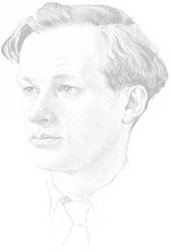page 2
1936-1939: The early weeks of 1936 marked a low point of JLM's life. He was unemployed, penniless and socially in disgrace after jilting his fiancée. But that spring he landed the job of his dreams as secretary to the newly-formed Country Houses Committee of the National Trust - a job he owed to Harold Nicolson, whose wife Vita's former lover was the sister of the N.T's Secretary Matheson. Formerly devoted to preserving beauty spots, the N.T. had only recently adopted the conservation of country houses as one of its purposes. JLM's task was to help compile a list of the houses most worthy of preservation, approach the owners, and visit such of them as were potentially interested in arrangements with the N.T. He threw himself into these activities with almost religious fervour; and although few properties came to the N.T. at this period, he acquired knowledge and skills which would later prove invaluable. He was unconcerned about his minuscule salary, or the fact that his restricted budget sometimes obliged him to visit such great houses as Longleat by bicycle. His conservation work led to friendships with Robert Byron and Michael, Earl of Rosse (brother of JLM's school love Desmond Parsons who had recently died), with whom he was involved in founding the Georgian Group in 1937.
 His work boosted his self-confidence and he began to lead the astonishingly varied social life later depicted in his diaries, which included Eton friends, the Harold Nicolson circle, aesthetes, bohemians, country house owners, the world of the great London hostesses, and old Catholic families such as the Herberts and FitzAlans. He continued writing and produced a novel, a book of short stories and much poetry, none of it considered publishable. There were at least two women to whom he considered proposing at this period (one the sister of Laura Herbert who married Evelyn Waugh); but his greatest romantic interest was Rick Stewart-Jones, a fellow conservationist working for the Society for the Protection of Ancient Buildings with whom he fell in love at first sight on 1 March 1938. They embarked on a passionate affair - which was still going strong in the summer of 1939, when JLM began another, less intense affair with Stuart Preston, a young American protégé of Harold Nicolson.
His work boosted his self-confidence and he began to lead the astonishingly varied social life later depicted in his diaries, which included Eton friends, the Harold Nicolson circle, aesthetes, bohemians, country house owners, the world of the great London hostesses, and old Catholic families such as the Herberts and FitzAlans. He continued writing and produced a novel, a book of short stories and much poetry, none of it considered publishable. There were at least two women to whom he considered proposing at this period (one the sister of Laura Herbert who married Evelyn Waugh); but his greatest romantic interest was Rick Stewart-Jones, a fellow conservationist working for the Society for the Protection of Ancient Buildings with whom he fell in love at first sight on 1 March 1938. They embarked on a passionate affair - which was still going strong in the summer of 1939, when JLM began another, less intense affair with Stuart Preston, a young American protégé of Harold Nicolson. 1939-1945: The outbreak of war in 1939 led to a return of JLM's depression. His job at the N.T. ended, and he took a grim view of the future. During the Phoney War he trained as an ambulance driver, and organised an exhibition in support of the Finns. In the spring of 1940, when he was about to be called up, Michael Rosse arranged for him to be commissioned in the Irish Guards. An uproarious account of his six months as a reluctant warrior is given in Another Self. Soon after being caught in a bomb blast in London in October 1940, JLM fell ill. For almost a year he was confined to military hospitals, his condition eventually being diagnosed as Jacksonian epilepsy.
As JLM returned to health in the autumn of 1941, the N.T. was returning to life, as desperate country house owners began to look to it for the future salvation of their currently requisitioned properties. Through the influence of his old boss, the remarkable Oliver, Viscount Esher, JLM was discharged from the army and allowed to resume his old job, now based at West Wycombe Park where he went to live. There he endured the haughty behaviour of the châtelaine, Helen Dashwood, but was comforted by the presence of two old friends, the novelist Nancy Mitford and music critic Eddy Sackville-West. He also established a lifelong close friendship with the artist Eardley Knollys, a wartime recruit to the N.T. staff who would be his constant companion on N.T. expeditions for the next fifteen years.
From 1942 to 1945, JLM's life is documented in detail in his famous wartime diaries. These describe his visits round the country to beleaguered houseowners (many of them eccentric); his involvement in the wartime politics of the N.T.; the pursuit of intimate friendships with men such as James Pope-Hennessy and Stuart Preston, and women such as the mysterious 'Q'; the progress of the war, which closely touched him through the bombing of London and the deaths in action of such friends as Tom Mitford and Basil Ava; and the frantic social life of London during the Blitz - both at the tables of great hostesses and more intimate gatherings.
< PREVIOUS PAGE | NEXT PAGE >
TOP
Home | The Life | The Books | Bookshop | The Play | See & Hear | Visitors Book
